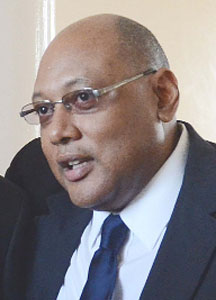If given the legal okay, the Wai Wai village of Konashen, in Region Nine, will this year be the newest protected area, Minister of Natural Resources Raphael Trotman yesterday reported to the National Assembly.
“We do have one other legal opinion that suggests we may take in the Konashen community,” Trotman said in response to People’s Progressive Party/Civic member Nigel Dharamlall when asked if any other protected areas had been designated this year.
However, he pointed out that the legal opinion will be sent to the Minister of Legal Affairs for further legal considerations before a definite decision is made.

The question was asked during the Committee of Supply’s ongoing consideration of the budget estimates.
Over $1.5B is earmarked in the proposed 2016 national budget to develop a comprehensive project to fund the development of the botanical and zoological parks and protected areas.
While Konashen is a protected area, it does not fall under government’s purview as it is Guyana’s first Community Owned Conservation Area (COCA) and is thus managed exclusively by the Wai Wais in partnership with Conservation International (CI).
According to the CI website, “This new protected area is part of the High Biodiversity Wilderness Area of Amazonia and a key part of the Guiana Shield corridor. It is home to several endangered species and the over 200 persons who live in the village of Masakenari. The Wai Wai need this area for the survival of their people and the traditional way of life and are worried about new and encroaching threats from mining, logging and the wildlife trade.”
It adds, “Incursions along their border with neighbouring Brazil have already led to illegal mining. The Wai Wais have already stopped trading in wildlife, a practice previously done solely for economic survival and are now looking to conservation and the benefits of keeping their biodiversity to provide for family and economic development. The protection of this area ensures continuity to the traditional lifestyle and with long term support they plan to continue living on the land.”
Meanwhile, detailing plans for the Environmental Protection Agency (EPA), National Parks Commission (NPC) and the Protected Areas Commission (PAC), Trotman yesterday informed that while he would have wanted more funds allocated to the agencies, his ministry will maximise what it has and partner with sister agencies to get the best value for money. He informed that the EPA is to be allocated $226.8M, while the NPC is to be allocated $180.9M and the PAC $62.5M.
While $200M overall is anticipated for a new office for the EPA, only $40M was budgeted for this year and will go towards concluding the design and starting construction of it. Trotman said that the Agency’s current location in Sophia was not apt for such an agency.
Questioned on if the 10 environmental officers for the agencies under his purview were adequate, he said no and pointed out that his ministry currently has a need for about 40 such officers. “No but this is what we have and this is what the Honourable Minister of Finance made available,” he noted while stating that emphasis will be placed on training.
Further, he explained that skilled persons from the diaspora have offered their services at “a very low rate” and the ministry was seeing how their skills and services can be used to supplement the human resources deficit.
Questioned by former Minister of Amerindian Affairs Pauline Sukhai on whether scholarships will be made available to Guyana’s first people to train them in fields needed by Trotman’s ministry, he explained that it was the Department of Public Service that looks at scholarships for persons countrywide.
However, he pointed out that there would be partnerships with indigenous communities in terms of training pertaining to conservation and environmental best practices and all equipment and specialist personnel will be afforded to them.
Turning to the NPC, which is responsible for the Botanical Gardens, Trotman disclosed plans for a $50M plan for an upgrade of the gardens. He said that his ministry envisages realising the original intent of botany behind the Botanical Gardens and for this to be done a lot of funds have to go towards infrastructural works.
Those works will include the raising of the walkway which is flood prone and building a walk-though exhibit.
Trotman was also probed about plans for training of persons in the oil and gas sectors given that Guyana was poised to soon be an oil producing country.
He said that government was partnering with the University of Guyana and West Indies to having persons trained once they have been identified.









